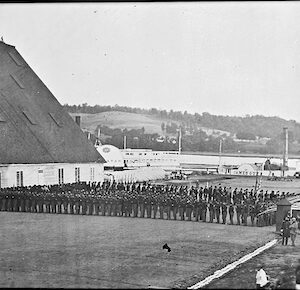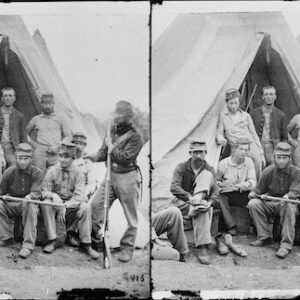Tag: 71st New York Infantry
Wikipedia says: The 71st New York Infantry Regiment is an organization of the New York State Guard. Formerly, the 71st Infantry was a regiment of the New York State Militia and then the Army National Guard from 1850 to 1993. The regiment was not renumbered during the early 1920s Army reorganization due to being broken up to staff other units from 1917 to 1919, and never received a numerical designation corresponding to that of a National Guard regiment.
In the fall of 1849, the Order of United Americans, related to the Know Nothing Party, held a meeting to organize a “distinctively American regiment.”
The 71st New York was formed on October 23, 1850, and was called “The American Rifles” and later “The American Guard.” Originally, the founders, J.M. Parker, Hamilton W. Fish, Sr, Hamilton W. Fish, Jr. and William Kellock, had political links to the Know-Nothing Party. Initially there were six companies recruited. One officer in A Company, Captain Parker, resigned after hearing a “foreigner” paraded with the “American Rifles.”
In Spring 1852, the American Rifles had eight companies, enough to be enrolled as a regiment of the state militia, and were assigned the regimental number of 71st. Its first commander was Colonel Abraham S. Vosburgh, previously its quartermaster. Vosburgh would remain commanding officer until his death on May 20, 1861. Henry P. Martin, previously adjutant, became lieutenant colonel in 1854. He would remain with the 71st through the first years of the Civil War. Its arsenal was located at Seventh Avenue and 35th Street.
The regiment became the “American Guard” in 1853 when their Ogden long rifles were replaced with muskets, which could carry bayonets. These, in turn, were replaced with Minie rifles in 1857.
On July 4, 1857, the regiment, along with the seventh New York, served as riot control personnel during the riots in the Sixth Ward between the Dead Rabbits and the Bowery Boys. During this action, Dead Rabbit leader Mickey Free was killed and the regiment captured an 8-lb howitzer from the rioters. The regiment was called into action again during the quarantine riot of September 1858 in Staten Island.
In 1858, the “Light Guard,” New York’s oldest military unit, detached from the 55th New York and became A Company. This led to some tension, because the “Light Guard” had several “foreigners” in the ranks.
On April 16, 1861, 380 men mustered under Colonel Vosburgh at the State Arsenal, in response to President Lincoln’s call for 75,000 troops. On April 21, the 71st paraded down Broadway and headed to the front.
Arrival in Washington
The 71st, then called to service for three months under Colonel Henry P. Martin, arrived in Washington on May 21, 1861, and was bivouacked at the Washington Navy Yard. While the army assembled, a team made up of members of the regiment defeated the Washington Nationals baseball club by a score of 41 to 13.
The regiment took part in the occupation of Alexandria, Virginia, in May 1861, accompanying the New York Fire Zouaves and Colonel Ephraim E. Ellsworth, who was killed in the action.
A detachment of the 71st, with two howitzers, fought at Acquia Creek and Port Tobacco in May and June 1861. Private Charles B. Hall was the first man injured on any U.S. vessel in the war.
First Battle of Bull Run
The 71st New York State Volunteer Infantry was organized in the Second Brigade (Colonel Ambrose Everett Burnside) of the Second Division (Colonel David Hunter). On July 21, 1861, the 71st Infantry, under Colonel Martin’s command, took part in the First Battle of Bull Run. Archaeological research on the battlefield at Manassas shows the 71st, along with the 1st and 2nd Rhode Island Infantry, faced the Tiger Rifles of Major Chatham Wheat’s Louisiana Battalion, the only known unit engaged in fighting outfitted with .54-caliber muskets. The 71st supported the advance of the 2nd Rhode Island against Wheat’s battalion. The Illustrated London News noted “The militia stood firm, firing and loading as if it were on parade.”
Colonel Burnside’s after-action report of July 24, 1861, noted:
It was nearly 4 o’clock p.m. . . . when I was ordered to protect the retreat. The Seventy-first Regiment New York State Militia was formed between the retreating columns and the enemy by Colonel Martin, and the Second Regiment Rhode Island Volunteers by Lieutenant-Colonel Wheaton.
His follow-up after-action report added, “I beg to again mention the bravery and steadiness manifested by Colonel Martin and his entire regiment, Seventy-first, both-on the field and during the retreat.”
Casualties included 62 officers and men. The regiment was mustered out of service in New York on July 20, 1861. It was remustered on May 28, 1862, under Colonel Martin, and returned to the man the defenses of Washington in 1862.
Chancellorsville
Colonel Henry K. Potter commanded the 71st New York State Volunteers (distinct from the 71st NYSNG), which was placed in the Second “Excelsior” Brigade (Brig. Gen. Joseph W. Revere) of the Second Division (Maj. Gen. Hiram G. Berry) of the Third Corps (Sickles) in the Battle of Chancellorsville in May 1863.
Gettysburg
The 71st passed through Chambersburg, Pennsylvania, on June 23, 1863, it is often confused with the 71st New York Volunteers, an entirely separate, three year volunteer regiment, which fought at the Battle of Gettysburg, as part of Sickle’s III Corps, again in the Second “Excelsior” Brigade (Colonel William R. Brewster). The 71st militia served in the defense of Harrisburg during the battle of Gettysburg.
Return to New York
After the battle, the 71st was recalled to New York City to help suppress the 1863 draft riots (the militia unit that was mobilized to defend Harrisburg, not the volunteer unit that was involved with the actual battle at Gettysburg). The regiment was mustered out of service in 1864. Many members of the 71st joined the 124th New York, which carried on the name “The American Guard.” and took part in the Petersburg campaign. Others joined other regiments.
Showing all 2 results

